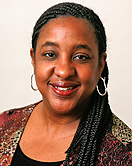News
Childhood memories inspire research
on abandoned Buffalo properties
Kelly Patterson has not forgotten the history of her hometown.
The Buffalo native still reminisces about the Thursday evenings she and her girlfriends spent downtown for an evening of excitement and shopping at AM&A’s department store and stores within the city’s once-vibrant Main Place Mall.
But those days are gone.
“It’s disheartening to see the decline of the city where you grew up,” says Patterson, assistant professor in UB’s School of Social Work.
And while many families and businesses have left Buffalo, what troubles Patterson is what have remained—the buildings they once occupied.
The overwhelming number of empty buildings in the city reminds her of the setting for a zombie flick. But instead of people, the houses are the living dead.
This analysis inspired the title for Patterson’s recent article, “Dawn of the Dead City: An Exploratory Analysis of Vacant Addresses in Buffalo, NY 2008-2010,” which recently was published in the Journal of Urban Affairs.
Her article was reviewed in The Atlantic Cities by Richard Florida, a renowned urban studies theorist and senior editor at The Atlantic.
Along with Li Yin and Robert Silverman, both associate professors in UB’s School of Architecture and Planning, Patterson studied the causes and patterns of abandoned properties in Buffalo.
The comparison between vacancies and the dead led to what the group calls “zombie properties.”
Zombie properties are buildings that are usually boarded up, contain health hazards and have extensive structural damage. They serve no purpose, bring down property values and are nothing more than lifeless shells.
The opposite of these buildings are temporary, obsolete, abandoned and derelict sites, or TOADS for short. TOADS consist of buildings that are only temporarily vacant, such as apartments and unsold homes.
The obvious answer to the “zombie” problem would be to tear the properties down. But Patterson doesn’t believe the solution is that simple.
“Demolishing these structures without an adequate plan doesn’t improve the area,” cautions Patterson. “Once they’re removed, you’re then left with an empty space in a dying region.”
Often these properties are left standing because that alternative is cheaper than renovating or tearing them down, she says.
The researchers say Buffalo appears to be in a continuous state of decline, where the rate of abandonment outpaces demolitions. In 2009, almost 29,000 homes—or 20 percent of all Buffalo homes—were vacant, over half of which were abandoned.
Many of the people of Buffalo are leaving. And Silverman believes they are following the jobs. Over the past 40 years, Buffalo has lost 80 percent of its manufacturing jobs and over half of its population.
He adds that while Buffalo is an extreme example, most of the Rust Belt cities across New York, Ohio, Pennsylvania and Michigan all wrestle with the same issues.
Replacing industrial careers are low-wage service jobs and high-paying technology-based work, the latter of which requires higher education. The ultimatum: Go back to school or move.
“People want to live well,” says Patterson. “So they’re moving to where the jobs are plentiful, the weather is nicer and the housing is affordable.”
And that place is the Sunbelt, particularly Florida, Georgia and Texas. Despite the economic problems the nation is facing, many cities in the Sunbelt are growing, Patterson says.
Businesses are headed in that direction, as well, the researchers point out. Companies flee high New York State taxes for the low tax rates and inexpensive real estate in the South.
But don’t lose hope just yet. The researchers say that although Buffalo is a shrinking city, there is reason for optimism: Universities, hospitals and colleges have emerged as the new urban regime, replacing factories as the employment and economic development engines.
Just as Yale University emerged to promote university and medical expansion as a remedy for the economic troubles of New Haven, Conn., UB and other Buffalo institutions are spearheading a similar strategy in reinventing Buffalo.
Along with Kaleida Health and Catholic Health, UB is one of the largest employers in the city. And the development of its downtown medical campus, now under way, will stimulate more growth, the researchers say.
Although Buffalo is working to transform its image and economy, more needs to be done. Various areas of the city haven’t benefited from growth within the medical corridor—African-American neighborhoods, in particular.
“There is an equity issue involved with investment in the downtown medical campus,” says Silverman. “When UB and hospitals expand in Buffalo, they need to include in their plans creation of employment and housing opportunities for residents who are displaced by their development.”
In 2010, the university formed an advisory council of local leaders to open pathways to jobs created by UB’s expansion to the downtown Buffalo medical campus.
The UB faculty members stress that before solutions can be found, the problem must be understood. They hope their research will provide the framework for policies that will reverse the growth of zombie properties in Buffalo and similar cities.
Read “Dawn of the Dead City: An Exploratory Analysis of Vacant Addresses in Buffalo, NY 2008-2010” in the Journal of Urban Affairs.


Reader Comments